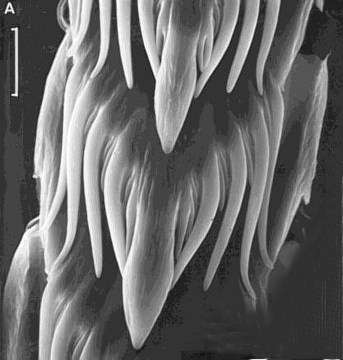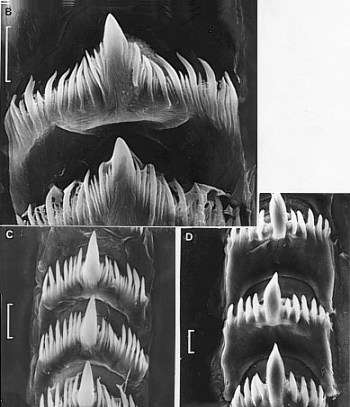

Coral feeding - radular adaptations
PHOTO
Radular teeth of:
A, Phestilla lugubris
B, Cuthona poritophages
C, Pinufius rebus
D, Phestilla minor.
Scale bar = 10 microns. PHOTOS: Diane Hughes.
RELATED TOPIC
The aeolid nudibranchs Phestilla lugubris, Phestilla minor, and Cuthona poritophages, and the arminoidean Pinufius rebus, all feed on the coral Porites, and have remarkably similarly-shaped radular teeth, with long slender denticles. In the three smaller species, the tooth is much smaller than found in close relatives, while in the case of the larger Phestilla lugubris the teeth are much larger. It would seem that this is an adaptation for feeding on the thin layer of tissue which overlays the coral skeleton. The three smaller species scrape out the polyp in each calyx, while the larger size of P. lugubris enables it to scrape across a number of calices as it feeds.
References:
•Rudman, W.B. (1979) The ecology and anatomy of a new species of aeolid opisthobranch mollusc: a predator of the reef-forming coral Porites. Zoological Journal of the Linnean Society 65: 339-359.
•Rudman, W.B. (1981) Further studies on the anatomy and ecology of opisthobranch molluscs feeding on the scleractinian coral Porites. Zoological Journal of the Linnean Society 71: 373-412.
•Rudman, W.B. (1982) The taxonomy and biology of further aeolidacean and arminacean nudibranch molluscs with symbiotic zooxanthellae. Zoological Journal of the Linnean Society 74: 147-196.
Rudman, W.B., 1999 (October 4) Coral feeding - radular adaptations. [In] Sea Slug Forum. Australian Museum, Sydney. Available from http://www.seaslugforum.net/factsheet/corafeed
